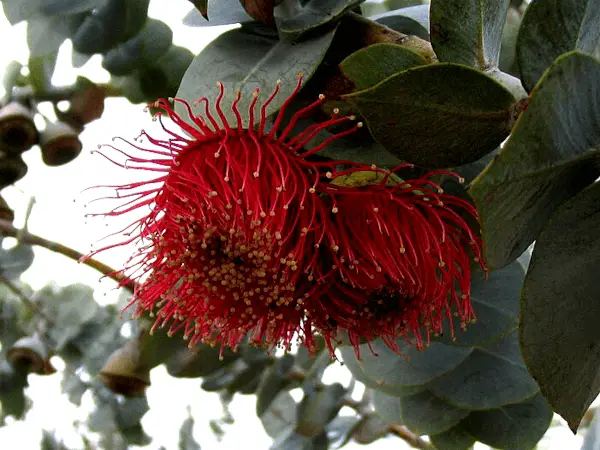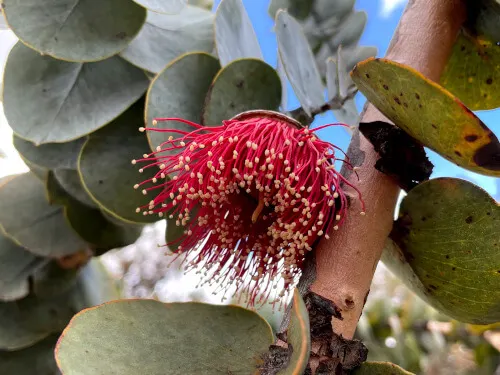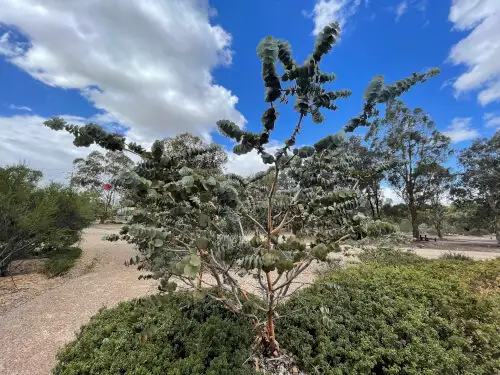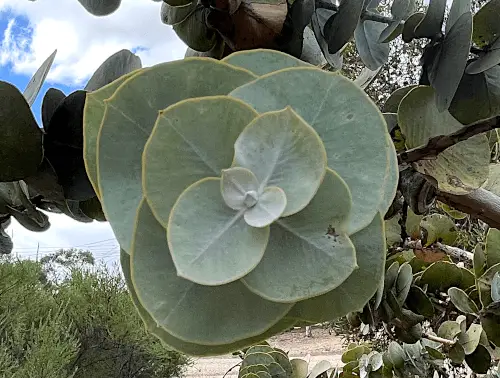
| Botanic name | Eucalyptus rhodantha |
| Other names | Rose Mallee |
| Main Origin | Southwestern Western Australia |
| Mature size | 2 – 4 m x 2 – 4 m (w x h) |
| Mature form | Straggly, spreading shrub or tree |
| Foliage | Silvery-green, round or heart-shaped |
| Growth rate | Moderate |
| Position | Full sun |
| Soil | Prefers sandy or gravelly soils, adaptable to clay |
| Water | Minimal, deep watering during prolonged dry spells |
| Climate | Mediterranean, warm temperate, mild subtropical |
| Flower | Bright red to pink, creamy white, from autumn to spring |
| Use | Feature specimen, screening, mixed ornamental |
| Notes | Prefers low to moderate humidity |
IN THIS ARTICLE
Overview
Eucalyptus rhodantha, or Rose Mallee, is a stunning miniature eucalypt for dry ornamental gardens. Its sculptural form, unique foliage, and magnificent flowers are a testament to nature’s artistry, standing out in the arid landscape with an enduring grace that captivates and inspires.
This stunning plant is, however, a vulnerable species due to habitat loss, land clearing, and its naturally restricted, fragmented distribution. Conservation efforts focus on habitat protection, seed collection, and cultivation in gardens and reserves to ensure its continual existence and expansion.
As a stunning ornamental species, Eucalyptus rhodantha is highly suitable for drought-prone, low-maintenance gardens as a feature or screening plant. This rare plant is our native treasure that symbolises the beauty of Australia’s rugged outback.
Origin and distribution
Rose Mallee is endemic to a relatively restricted, small region, north of Perth in Western Australia. It is often found in flat, undulating, or hilly heathland with a Mediterranean climate, characterised by hot, dry summers and cool, wet winters with rare frost occurrences.
This ornamental shrub is widely cultivated in residential and public gardens. The plant has been successfully grown in warm temperate and mild subtropical zones, but generally performs best in drier climates similar to its original habitat.

Growth and care
Eucalyptus rhodantha is a hardy, drought-tolerant species that thrives in full sun. It prefers sandy or gravelly soils but can adapt to well-drained, heavier soils like clay. The plant flourishes in dry conditions and does not like moist environments.
While the young plant requires regular watering during dry periods, established Eucalyptus rhodantha is a highly drought-resistant plant that requires minimal or occasional deep watering during extended dry spells. This species can tolerate mild frost.
Eucalyptus rhodantha thrives in nutrient-poor soils and generally requires minimal fertilisation. However, adding organic matter such as compost while planting can enhance plant growth in the early stage.
Mulching around the young plant helps soil conditioning for stronger root development. Applying a slow-release native plant fertiliser in early spring can also support lusher growth, especially in sandy or nutrient-depleted soils.
Pruning Eucalyptus rhodantha is essential for maintaining its sculptural form, encouraging healthy growth, and promoting abundant flowering. Light pruning can be performed after flowering to remove spent blooms and shape the tree.
For a bushier appearance, tip-pruning young plants can encourage denser growth. Heavy pruning should be avoided, as this plant does not respond well to excessive cutting.

Features
Eucalyptus rhodantha naturally adopts a distinct, low-spreading, multi-stemmed form similar to other straggly mallees like Eucalyptus kruseana (Bookleaf Mallee) and Eucalyptus marocarpa (Mottlecah).
It is often grown as an ornamental shrub but can be trained into a small tree with consistent pruning effort, especially when the plant is young. The plant can reach 2 – 4 meters in width and height.

The bark of Eucalyptus rhodantha is smooth and light brown to grey, often shedding in thin ribbons to reveal fresh surfaces beneath, adding to its sculptural appeal. Its branches are twisting and gnarled, extending outward to create a low-spreading canopy.
The foliage is one of its most distinctive features – large, round or heart-shaped, and covered in a silvery waxy coating. Unlike most eucalyptus trees, the juvenile foliage form persists throughout the plant’s life without variation.

These spectacular leaves are thick and leathery. As the branch extends, they are developed as opposite pairs with alternate right-angle orientations. When inspected closely, each silvery-green, rounded leaf is perfectly spaced along the branches, creating uniquely beautiful overlays.
Another striking feature is its large and showy, red, pink or cream flowers. Each blossom consists of numerous long, thread-like stamens that radiate outward, with bright yellow anthers at their tips, resembling a starburst.
The flowers emerge from distinctive, silver-grey buds with a beaked, conical cap during winter and spring. These nectar-rich flowers attract birds, bees, and other pollinators, making this plant a great species for supporting wildlife.
Large, ornate, bowl-shaped woody gum nuts form following the blooms.

Landscape uses
- Feature specimen: A striking focal point in ornamental gardens due to its sculptural form, bold flowers, and unique foliage.
- Wildlife garden: Attracts birds, bees, and pollinators with its nectar-rich flowers, supporting biodiversity.
- Rock garden: The straggly, sculptural form pairs well with rocks and gravel in a low-maintenance, water-wise garden.
- Informal screening: The low-spreading habit is ideal for informal, loose screening.
- Container planting: A miniature species rarely grows beyond 3 meters, ideal for pots and large planters.


